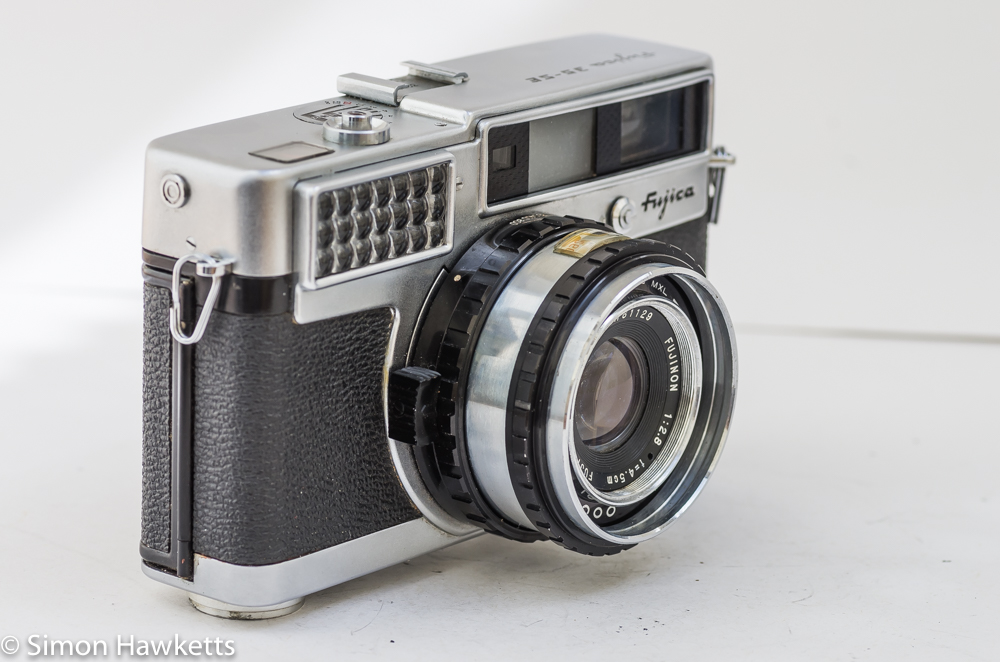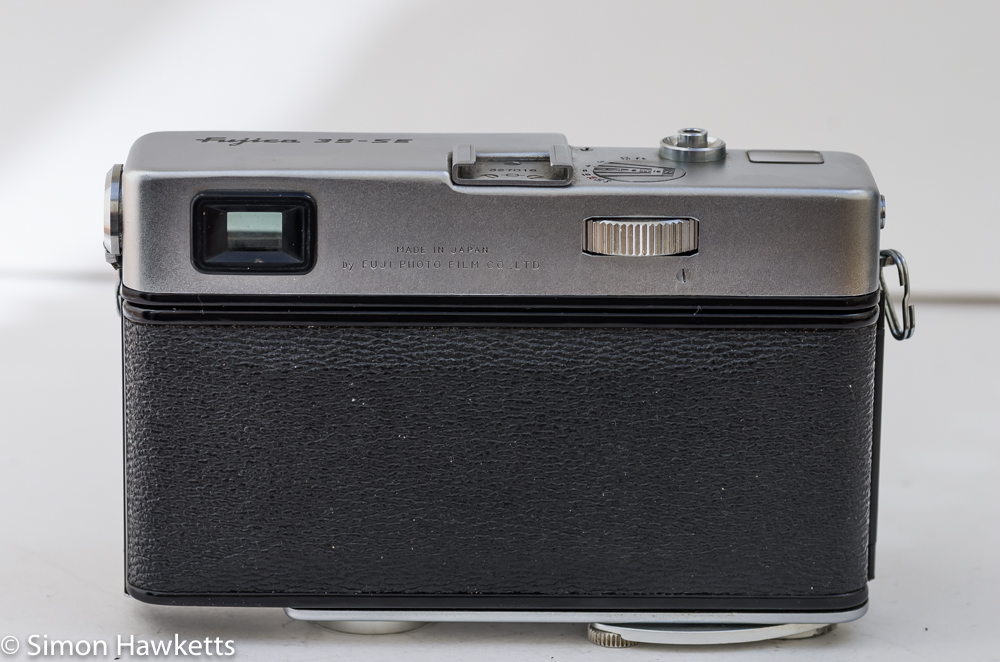Fujica 35-SE 35mm rangefinder camera
The Fujica 35-SE is a 35 mm rangefinder camera which was made in Japan by the Fuji Photo Film co in about 1959.
Fujica 35-SE images










My Fujica 35-SE Camera
I bought this camera for only a few pounds from eBay, mostly because it looked a bit more interesting than the majority of 35 mm rangefinder cameras I own.
When I received it from the seller, I discovered a camera which had only one cosmetic problem, and a number of mechanical issues.
The cosmetic problem is to do with the film advance lever. It seems to be made of a soft metal (aluminium) and has had a scrape at some time which has damaged the surface. This has resulted in some aluminium oxide being produced and some general corrosion on the film type reminder dial which is part of the advance lever. Although this is cosmetically a bit unsightly, it hasn’t affected the use of the control.
The mechanical issues are 3-fold.
The first was a problem with the shutter and was specified in the seller’s description of the camera. He described it as ‘camera winds but won’t click’. Well, when I received it the camera advance had been wound, but when I pressed the shutter release the shutter didn’t open, but the film advance was unlocked. I tried winding and firing the shutter a few times and the shutter sprang to life, but was firing as the film advance was returned to the stop.
This action continued for a day or so, and then as I kept trying the shutter it started to work normally, at first only once every few strokes, and then gradually more often until eventually it worked correctly every time. It looks like the problem was simply one of not being used for several years, and once the controls were operated again it sorted itself out. I’m glad to say that the shutter times seem to be spot on and even the self-timer is working correctly.
The other mechanical issues are to do with the light meter and what’s termed the meter coupling button in the hand book. The coupling button is used to unlock the shutter speed & aperture rings. This camera in effect uses the EV system, and the button is supposed to allow you to override that lock and set individual speeds and f-stops. On my camera, it doesn’t seem to do anything, since I can set those separately anyway. It may be I’ve interpreted how it is supposed to work incorrectly, or it actually doesn’t work – I’ll only know for sure by taking it apart and seeing what it is supposed to do.
The final thing which seems to be wrong is the light meter – or rather the light meter cell which seems to be inaccurate. That isn’t completely surprising considering the camera is about the same age as me – it’s a common problem that light cells lose their ability to generate voltage over time.
Fujica 35 SE description
The Fujica 35 SE is a somewhat unusual camera when compared to the many rangefinder cameras available when this camera was made.
First, a few words about the camera generally. It’s a solidly made and heavy camera which looks very well-made. I don’t have a lot of experience with the Fujica line up, but if the build quality of this unit is anything to go by they are a pretty nicely made camera.
I think for me the stand-out features of this model are the focusing, the viewfinder and the exposure system.
Normally, a coupled rangefinder camera has the split viewfinder coupled to the front element of the lens so that the focus adjustment is made on the lens. On the Fujica 35 SE, instead of this arrangement, there is a separate focus control on the back of the camera on the opposite side from the viewfinder. This actually feels like quite a good place to fit the focus, because your thumb naturally falls in that location when you hold the camera to your eye – well, naturally if you are right-handed. (Have you ever noticed that nearly all cameras are made for right-handed people?)
Because the focus is controlled by this thumb wheel, the usual distance scale on the lens is instead inscribed on the top of the control, where is fits into the top plate of the camera. So if you want to focus by zone rather than by the normal rangefinder split image, you can set the focus using the really rather neat depth of field markers on the dial.
This is the first camera that I’ve seen with this sort of focus control. Without looking at how it works, I initially thought it must be more complex, but actually it probably isn’t. Because the movement of the focus element of the lens needs to drive the rangefinder, it is just the same level of complexity as a more conventional camera – it’s just that the driving force is supplied from the other end of the mechanism.
The viewfinder is another part of the camera which is a bit different from the convention. The rangefinder is not out of the norm – it’s a perfectly normal, centre square with a yellow image which aligns when the subject is in focus. What is a bit different are the framing lines, which move as the focus is adjusted to compensate for the change in parallax error. Although this camera isn’t unique in offering this feature, it wasn’t common in most rangefinders of the time.
I think the third nice feature is the way the exposure system is locked together once the correct exposure is set. This is just the same as the cameras which use the Exposure Value system, although this Fujica doesn’t have the EV markings.

The way the exposure system is meant to work is by setting the shutter speed using the front control ring on the lens, and then move the aperture control ring until the light meter needle is positioned over the small black square in the middle of the scale. Once set, the shutter speed control can be moved and the meter needle will stay centred, but the aperture and shutter speed combination will be changed in a ‘one stop up – one stop down’ way.
I think originally, this ‘locking’ of the aperture and shutter dials could be overridden using the button on the front of the camera, but on my model when I get to the end of the range the dials move out of the lock anyway. I suspect the mechanism which prevents it is probably stuck and needs a clean to work properly.
Aside from those particular features, there are other things which are unusual on the 35 SE. The rewind control, for example, is on the side of the body rather than the top plate. That seems to have been because the viewfinder is fitted quite a long way to the left-hand side of the body, rather than the slightly more central location most manufacturers used. Also, the film advance and frame counter are mounted on the bottom plate of the camera rather than on the top, which again is not unknown but a bit unusual.
I suspect these variations were just Fujica’s way of trying to differentiate themselves from the other manufacturers of the time – for camera collectors today, I find it a welcome change from the norm.
Fujica 35 SE specifications
- Fujica 35 SE 35mm rangefinder camera
- Shutter speeds 1 sec to 1/1000 sec + B
- Solid and well engineered camera
- Focusing control built into back of camera rather than round the lens
- Focusing scale and depth of field indicator on top plate
- Film advance lever on bottom plate
- Auto reset frame counter on bottom plate
- Flash sync for X or M flash
- Mechanical self timer
- Side mounted rewind crank
- Split image rangefinder and paralex correction in viewfinder
- Built in light meter
- Locked aperture and shutter speeds gives ‘EV’ type controls
- Film speed 12 to 800
- 45mm f/2.8 fujinon lens
- Body Ser No: 327016
- Lens Ser No: 761129
- Manual available on line here
Discover more from Everything Vintage
Subscribe to get the latest posts sent to your email.





